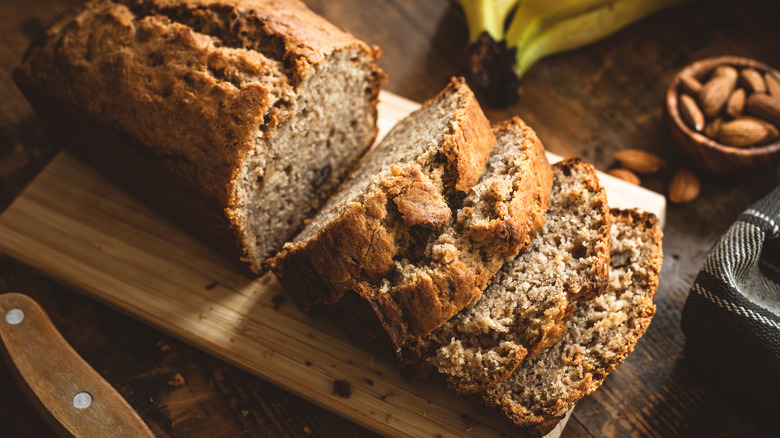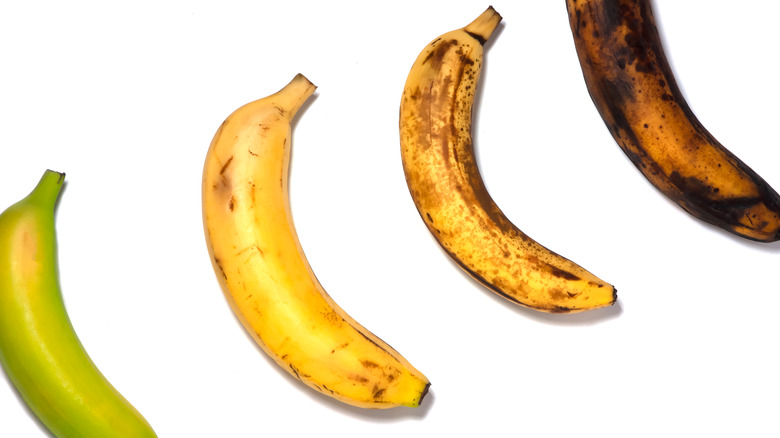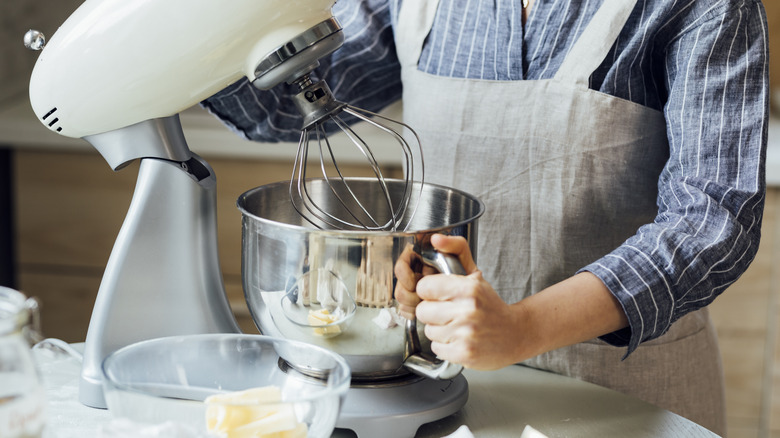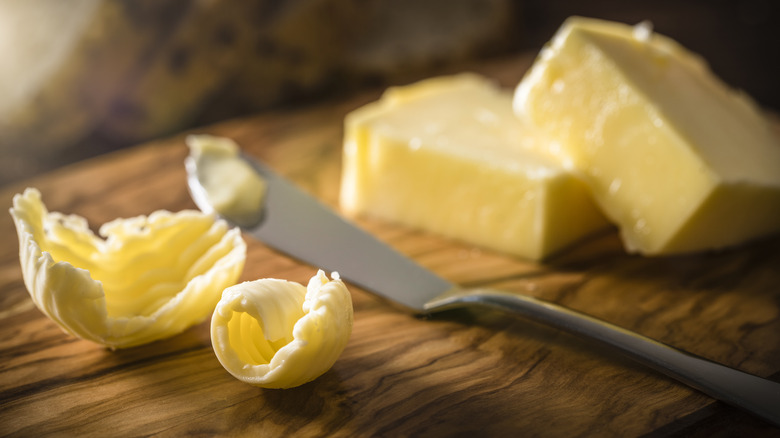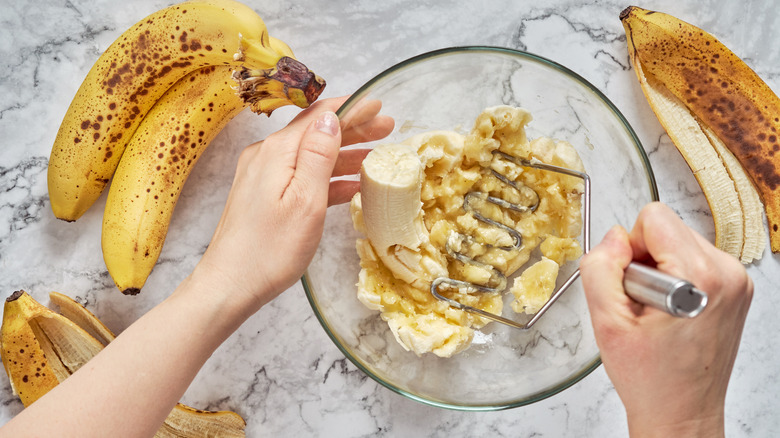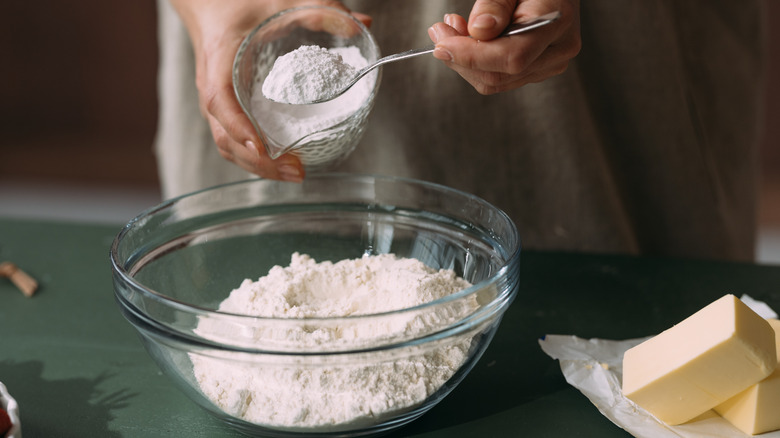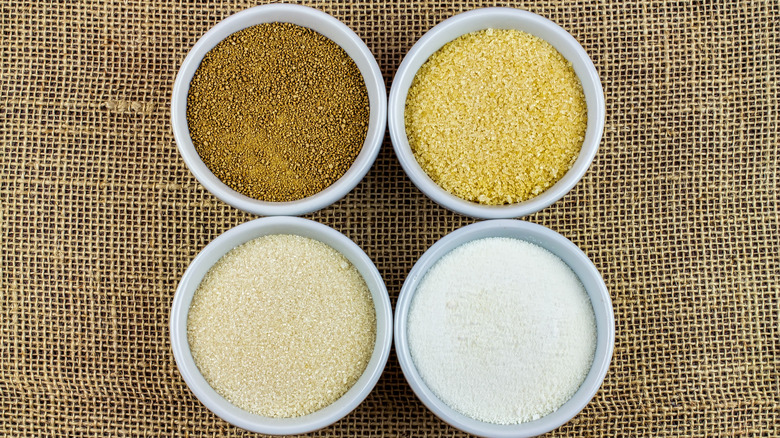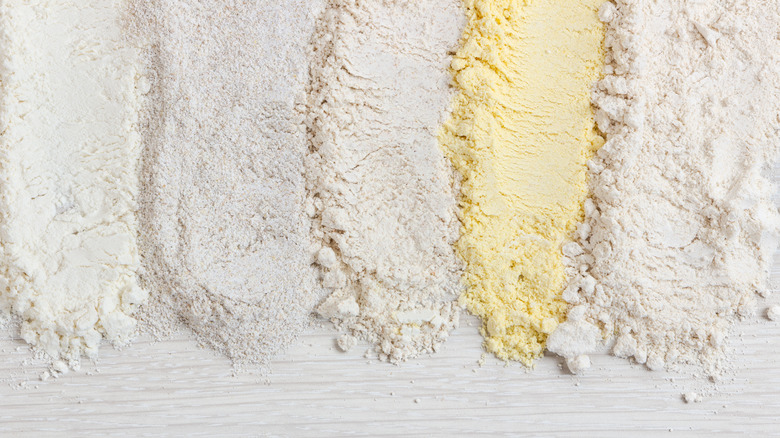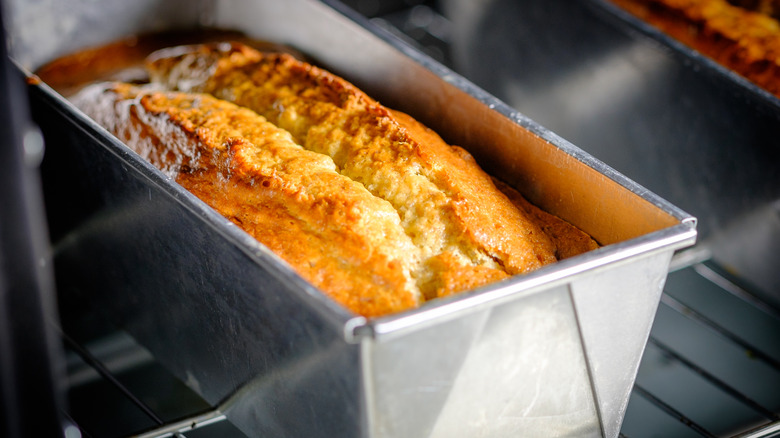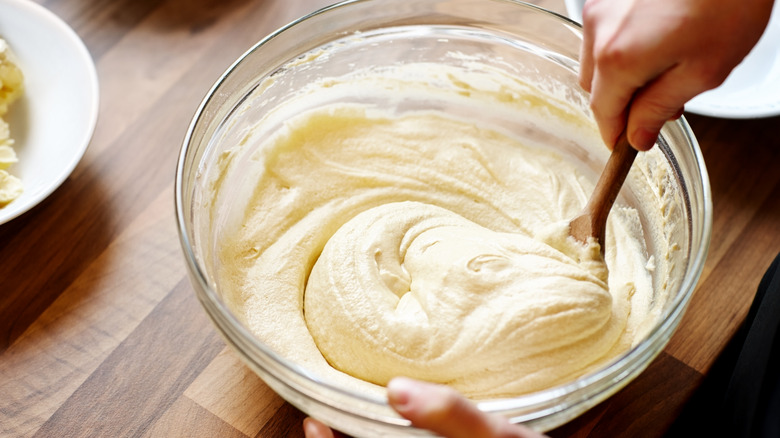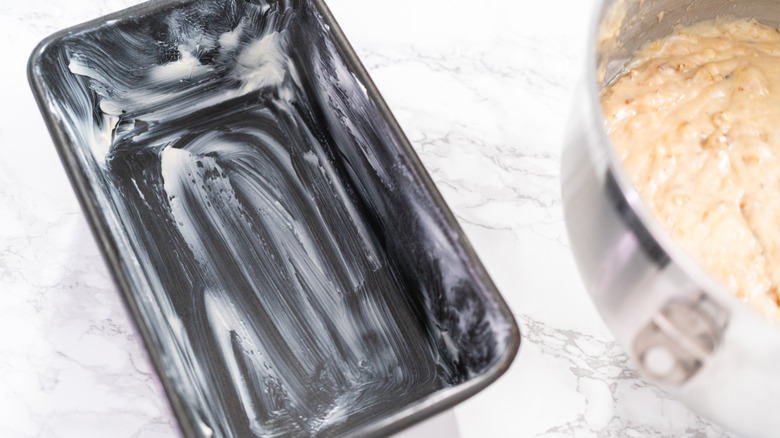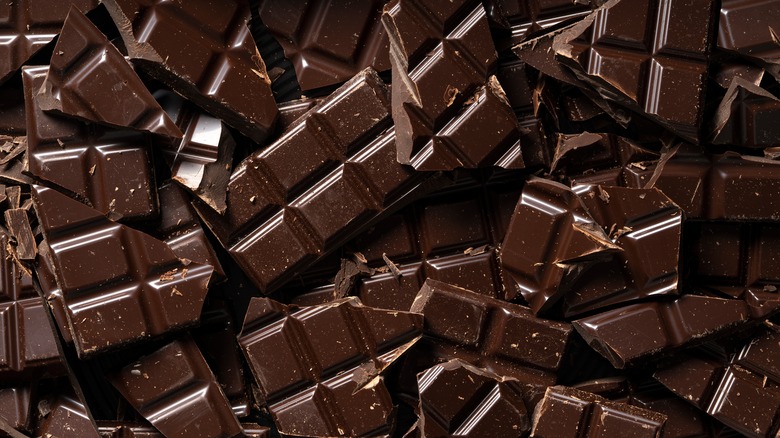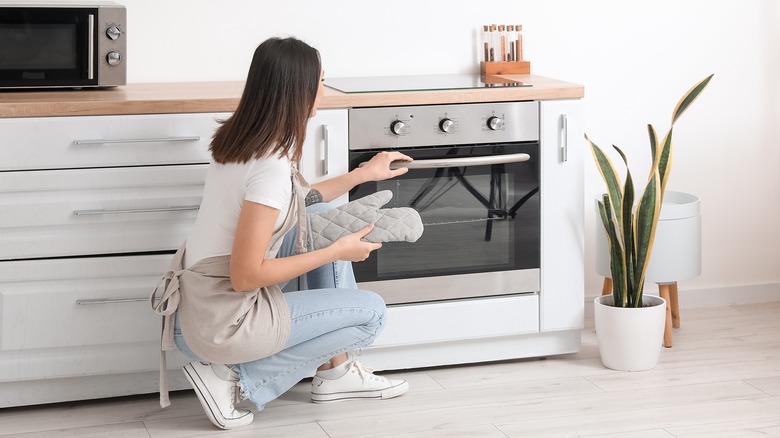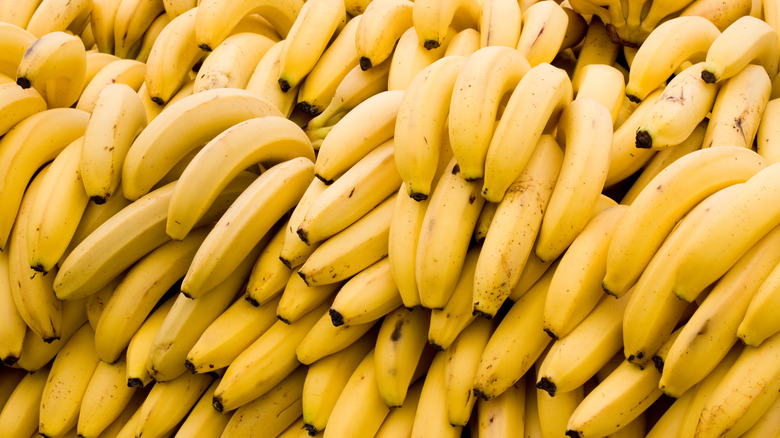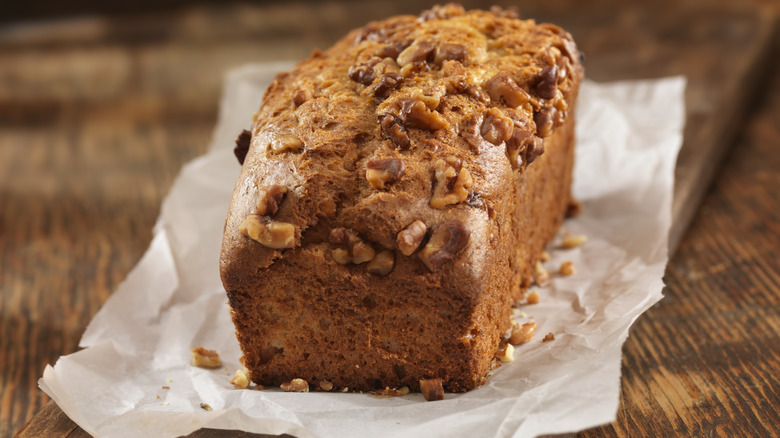Common Banana Bread Mistakes You Might Be Making
Back in 2020, banana bread had a moment. It was the era of banana bread, if you will. Everyone, stuck in their homes during the COVID-19 pandemic, turned toward this humble breakfast or anytime quick-bread in an effort to ... what exactly? Add some sweetness to their day-to-day? Distract from their innermost thoughts? Just try out baking in general? We may never know or understand why banana bread gripped us the way it did in 2020, but the lasting effects mean that this baked good's popularity rose and is here to stay.
If you're turning back inward toward the banana bread times, there are a few mistakes you can easily avoid to make the most well-baked, moist, and delightful treat you can. Adding nuts and/or chocolate, using the right number of bananas, and even knowing how much (and what kind) of fat to use can all help you in your quest for the perfect banana bread. That said, there are also many pitfalls on your way to banana bread greatness. These are some of the most common.
Using underripe or overripe bananas
Choosing the right ripeness for your bananas is probably the most important step in your banana bread quest. First, it's fairly common knowledge that bananas that have turned nearly black are generally regarded as the best for your banana bread. They add moisture and lots of sweetness. But is your banana too ripe for banana bread? If that black banana is sporting any kind of mold, generally bad smells, or is leaking brown liquid, it's best to toss it. If your bananas have turned brown or black and still seem okay, but you aren't quite ready to create your banana bread just yet, remove them from the peel, chop, and freeze until you're ready. When it's time to bake, simply defrost them at room temperature for a few hours or pop them in the microwave
Underripe bananas can be equally bad for your baking endeavors. Generally, underripe bananas are starchier, have developed much less sugar, and will add very little banana flavor to your bread. They may even dry it out. So, they could be good for eating, but if you're looking for banana bread bananas, save them and wait until they start to turn a little brown and black.
Overmixing the batter
As with any baked good, banana bread is finicky when it comes to how much or how little you're mixing it and incorporating all of those ingredients together. If you're making your banana bread in a mixer or with an electric handheld, once you've added the eggs, it's best to stop, scrape down your sides, and then finish off the batter-mixing by hand.
The general rule of thumb for banana bread is to mix until everything is just incorporated — or for about 10 seconds once all of your ingredients have been added. The problem with mixing too long is that — as a bread — the loaf will begin forming more and more gluten. Gluten is great for a boule or a baguette, but much less so for a quick bread for which the aim is more a cake-like, soft, and moist consistency. The longer you mix, the more chewy, dense, and even rubbery your banana bread can become.
Adding too much fat
Butter and oil are one of those things that seem like an all-around "good" when it comes to baking. They add tenderness, moisture, and an unctuous bite that just can't be achieved when they're left out. But the addition of too much butter or fat may be ruining your banana bread.
According to Insider, if your banana bread recipe calls for, say, a stick of butter, and you decide to add a stick and a half or even two whole sticks (maybe in an effort to clean out the fridge, or to just make a tastier end product), you could end up with a very oddly textured baked good.
Your overly-buttered banana bread could end up dry on the outside, moist on the inside, and lacking in your sought-after banana flavor if you overdo it on the fat. It won't be so bad that you'll want to toss the whole thing, but, in the case of fats and butter and banana bread, it's likely best to stick with whatever your particular recipe says.
Neglecting to pre-mash your bananas
So you've selected your specific banana bread bananas and are ready to start baking. A little prep work can't hurt. One of the things you can — and should — do before you start piling in and mixing your ingredients is to mash up your bananas separately before adding them in with your other ingredients.
If you're trying to achieve smooth banana bread with the flavor of those ripe, sweet bananas throughout, mashing is imperative. Before adding in your bananas, mash them with the back of a fork in a separate bowl. Once they're completely smooth — think of how you'd want them to look for a six-month-old baby trying some first foods — then you can add them in with your other wet ingredients. Part of the reason we'd opt for very, very ripe, black bananas in our banana bread recipe is because it makes this step — the mashing — that much easier.
Mismeasuring your flour
If you're more of a cook than a baker, your banana bread baking adventure is not the time to take a measuring cup and simply scoop your flour or to use your recipe's measurements as a loose suggestion. Precision in baking is of the utmost importance, and mismeasuring your flour is something that can take your banana bread from yay to nay very quickly.
If you simply scoop your flour and have a dome on top of your cup measure (i.e. you're using more than your recipe calls for), you will likely end up with a banana bread that's dry and stiff. If you're too scant in your measure, or simply don't put in the amount of flour being called for, your bread could be too moist and even underbaked in the middle. In the end, measure your flour correctly, and bake with a scale when possible. It may seem like just another step, but it could be the difference between good and great banana bread.
Ignoring different sugars
So it may feel a little counterintuitive to be swapping sugars in your banana bread, considering we just told you to follow your recipe. But swapping white sugar for brown sugar, turbinado sugar, or even a sugar alternative won't hurt your banana bread; it could take it to the next level of deliciousness.
A lot of recipes for banana bread will call for a mixture of brown and white sugar. If that's the case, it's okay to pick one or the other. If you're a fan of darker, more molasses-like bite and an overall richer bread, opt for more — or all — brown sugar. If you prefer a lighter bite — more on the neutral side — opt for classic white sugar or caster sugar, which is just white sugar that's been ground super fine so it dissolves more easily into baked goods, drinks, souffles, and more. There are about 18 types of sugar, so feel free to explore, experiment, and combine as you see fit.
Ignoring different flours
In the same vein of experimentation in the name of science, baking, and deliciousness, you should also try out different flours in your banana bread. Bread flour, cake flour, all-purpose flour, almond flour, and even coconut flour all have their pros and cons when it comes to banana bread, and finding recipes that utilize one or allow for swap-ins are fairly easy to find.
For heavenly banana bread, you can use half almond flour and half all-purpose flour. Almond flour, for the uninitiated, is blanched and peeled almonds that have been ground into a fine powder. It's also gluten-free. The almond flour will help to absorb excess moisture in your bread, lend a nutty note, and extend shelf-life. The all-purpose flour will help your bread to rise and provide the structure necessary.
You can also try substituting cake flour for lighter banana bread. And, if you're on a bit of a health kick, you can swap in whole wheat flour for a slightly nuttier taste and a higher protein content. You can also go half-and-half.
Not allowing it to cool
As soon as the timer dings and it's time to slide that banana bread out of the oven, you're probably doing everything you can not to dive right into the steamy, sweet goodness. What could it possibly hurt to take a slice or three while the bread is still hot, anyway? Turns out, quite a bit.
Yes, you should let your banana bread cool before eating it. Cutting into it early — or while it's still steamy and hot — can actually alter and mess with the structure of the bread, causing it to fall, flatten, and lose some of its airiness. If you're overly eager and simply cannot wait much longer to taste a slice, you can aid in the cooling of your banana bread by removing it from the baking pan after about two minutes and leaving it out on a wire baking rack. The rack will allow air to move around your loaf faster, cooling it much more efficiently than if it'd been left in the pan.
Mixing in the wrong order
For the bold among us, being told what order you need to mix ingredients in seems silly. It's all going to the same place, right? So why would it matter what order you mix things in? Why do you need a wet ingredient bowl and a dry ingredient bowl? What could happen? A lot, as it turns out.
Most ingredients call for mixing your dry ingredients — like salt, flour, and baking powder — in a separate bowl because it'll help incorporate those items better together. The same is true for the wet ingredients, like sugar, butter, eggs, and mashed bananas. Once wet and dry are both mixed separately, they can be mixed. Many recipes call for mixing half or a third of your dry ingredients into your wet ingredients to incorporate everything without overmixing later. The best thing you can do is to read through your entire recipe before even starting your baking process, so you're prepared and familiar with what you'll need to do before you do it.
Forgetting to grease the pan
A cardinal sin in baking is when you go to pull your cake, bread, or other baked goods out of the oven and realize you forgot to grease, butter, or oil your pan. Your baked goods may seem hopelessly stuck, and the beautiful, shiny exterior of your bread or cake may be ultimately ruined. Of course, some recipes don't require you to grease or flour your pans; chocolate chip cookies come to mind. The addition of more fat can cause your cookies to burn.
But when it comes to banana bread, you do need to grease and or flour your pan. Although most banana bread recipes have butter in them, there isn't a significant enough amount to prevent your bread from sticking. For banana bread, you can opt for non-stick cooking spray in your intended loaf pan, or you can go a step further and use butter, lard, or shortening. Just make sure you spread it all over and don't miss any spots. You can also dust flour over your fat or non-stick spray as an extra layer of protection, although it isn't necessary.
Skipping the nuts or chocolate
We can't think of many baked goods that wouldn't be improved by the addition of chocolate or nuts. Cookies, cakes, breads — all of them get an additional boost when things like dark chocolate chips or toasty walnuts are added. Banana bread lends itself to a high percentage of dark chocolate, so the addition of chopped good-quality craft chocolate is definitely warranted here. Look for a bar to chop by hand instead of adding typical chocolate chips. The chopped chocolate will give you a better texture once the bread is cooked.
If you're looking into adding nuts, look for something that keeps a crunch, like a walnut or a pecan. You can toast them quickly before adding them to your batter for added flavor, too. For any mix-ins, make sure you're not adding them until you're completely done incorporating the rest of the wet and dry ingredients in the batter. Fold everything in very gently, then pour into your prepared baking or loaf pans.
Baking too long, or not long enough
As with any baked good, the amount of time spent in the oven is of the utmost importance. The difference between a moist, raised, quickbread and a gooey, undercooked one; or — on the opposite end of the spectrum — a nearly burned, dried-out hunk of dough — is the amount of time and the temperature at which you bake.
The first rule is to preheat your oven. Most banana bread recipes are going to bake at around 350 F. As far as how long you need to bake, you'll need to first consult the recipe. Most banana breads do have a longer baking time since the batter is so dense. Once you start approaching the end of your banana bread's time in the oven, you'll need to look for a golden brown crust. If it looks okay, take a toothpick and insert it into the middle of your bread. If the toothpick comes out clean, you're good to remove the bread from the oven. If it pulls gooey batter away with it, let your bread cook a bit longer.
It's also helpful to know whether your oven runs a bit hot. When you bake other items, are they done faster than you thought? If the answer is yes, check your bread a bit before it's scheduled to be done.
Using too many bananas
It feels a little odd to say, but there is such a thing as using too many bananas in your banana bread. For banana bread, too much of the star ingredient is a huge mistake because it can lead to your bread being dense and mushy — refusing to rise or dry out regardless of how long it bakes. Bananas are usually good stand-ins for recipes calling for alternatives to bind other ingredients together, so it would make sense that too many could cause the dry ingredients to become too wet. A good rule of thumb is to use two cups of flour for every two cups of mashed bananas. This will ensure that the wet and dry balance each other out.
If you've added too many bananas and are worried about the wetness of your batter, add a few tablespoons of flour to even things back out. The addition should help soak up some of the extra moisture while still giving you the sought-after sweet banana flavor for your bread.
Improperly storing your banana bread
You've done it — you've made the perfect loaf of banana bread. It's chock-full of sweet, ripe bananas, is moist yet cake-like, and laden with dark chocolate chunks and crunchy toasted walnuts. This is your masterpiece. But how can you store it to not be faced with a dried-out loaf, or, even worse, one that sprouts mold in a matter of days?
The first step is knowing how long to let your banana bread cool completely once it's out of the oven. If you were to try to wrap or store your banana bread while it felt cool outside but was still warm inside, you could be faced with condensation trapped inside the container or plastic wrap, leading to excess moisture and dreaded mold. Once you're sure the banana bread is, indeed, completely cool, and if you're planning to eat the whole thing in under three days, you can store your banana bread on the counter in an airtight container with a paper towel under the loaf and one on top.
You can, of course, store your loaf in the refrigerator, but the cold air will cause it to dry out faster. Wrap the cooled loaf in plastic wrap completely, then slide it into an airtight bag or storage container. It should last a little over a week this way.
